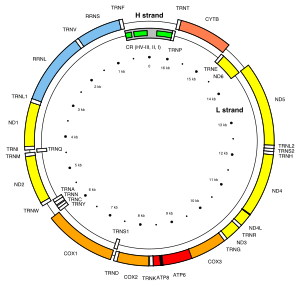Cambridge Reference Sequence

The Cambridge Reference Sequence (CRS) for human mitochondrial DNA was first announced in 1981.[2]
A group led by Fred Sanger at the University of Cambridge had sequenced the mitochondrial genome of one woman of European descent[3] during the 1970s, determining it to have a length of 16,569 base pairs (0.0006% of the nuclear human genome) containing some 37 genes and published this sequence in 1981.[2]
When other researchers repeated the sequencing, some striking discrepancies were noted. The original published sequence included eleven errors, including one extra base pair in position 3107, and incorrect assignments of single base pairs. Some of these were the result of contamination with bovine and HeLa specimens. The corrected revised CRS was published by Andrews et al. in 1999.[4] (The original nucleotide numbering was retained to avoid confusion.) The reference sequence belongs to European haplogroup H2a2a1. The revised CRS is designated as rCRS. It is deposited in the GenBank NCBI database under accession number NC_012920.[1]
When mitochondrial DNA sequencing is used for genealogical purposes, the results are often reported as differences from the revised CRS. The CRS is a reference sequence rather than a record of the earliest human mtDNA. A difference between a tested sample and the CRS may have arisen in the lineage of the CRS or in the lineage of the tested sample.[citation needed] The CRS includes seven nucleotides that are rare polymorphisms: 263A, 311C-315C, 750A, 1438A, 4769A, 8860A, and 15326A.[5]
An alternative African (Yoruba) reference sequence has also been used sometimes instead of the Cambridge. It has a different numbering system with a length of 16,571 base pairs and represents the mitochondrial genome of one African individual. Other alternative reference sequences that have also sometimes been used include the African (Uganda), Swedish and Japanese sequences.[6]
In 2012, it was proposed that the revised Cambridge Reference Sequence (rCRS), should be replaced by a new Reconstructed Sapiens Reference Sequence (RSRS).[7] The RSRS keeps the same numbering system as the CRS, but represents the ancestral genome of Mitochondrial Eve, from which all currently known human mitochondria descend. The RSRS should be more useful for comparing the changes in different haplogroups[3] although this has been debated.[8] Family Tree DNA reports results for mtDNA for both rCRS and RSRS.[3]
References[edit]
- ^ a b Homo sapiens mitochondrion, complete genome. "Revised Cambridge Reference Sequence (rCRS): accession NC_012920", National Center for Biotechnology Information. Retrieved on 30 January 2016.
- ^ a b Anderson S, Bankier AT, Barrell BG, de Bruijn MH, Coulson AR, Drouin J, Eperon IC, Nierlich DP, Roe BA, Sanger F, Schreier PH, Smith AJ, Staden R, Young IG (1981). "Sequence and organization of the human mitochondrial genome". Nature. 290 (5806): 457–465. Bibcode:1981Natur.290..457A. doi:10.1038/290457a0. PMID 7219534. S2CID 4355527.
- ^ a b c Aulicino, Emily D. (19 December 2013). Genetic Genealogy: The Basics and Beyond. AuthorHouse. p. 27. ISBN 978-1491840900.
- ^ Turnbull, Douglass M.; Andrews, Richard M.; Kubacka, Iwona; Chinnery, Patrick F.; Lightowlers, Robert N.; Howell, Neil (1999). "Reanalysis and revision of the Cambridge reference sequence for human mitochondrial DNA". Nature Genetics. 23 (2): 147. doi:10.1038/13779. PMID 10508508. S2CID 32212178.
- ^ Andrews, Richard M.; Kubacka, Iwona; Chinnery, Patrick F.; Lightowlers, Robert N.; Turnbull, Douglass M.; Howell, Neil (October 1999). "Reanalysis and revision of the Cambridge reference sequence for human mitochondrial DNA". Nature Genetics. 23 (2): 147–147. doi:10.1038/13779.
- ^ Lott, Marie (29 June 2015). "Complete Mitochondrial DNA Sequences". Mitoweb. Retrieved 14 November 2015.
- ^ Behar, Doron M.; et al. (6 April 2012). "A "Copernican" Reassessment of the Human Mitochondrial DNA Tree from its Root". The American Journal of Human Genetics. 90 (4): 675–684. doi:10.1016/j.ajhg.2012.03.002. PMC 3322232. PMID 22482806.
- ^ Bandelt H-J, Kloss-Brandstätter A, Richards MB, Yao Y-G, Logan I (5 December 2014). "The case for the continuing use of the revised Cambridge Reference Sequence (rCRS) and the standardization of notation in human mitochondrial DNA studies". Journal of Human Genetics. 59 (2): 66–67. doi:10.1038/jhg.2013.120. PMID 24304692. S2CID 21995571.
